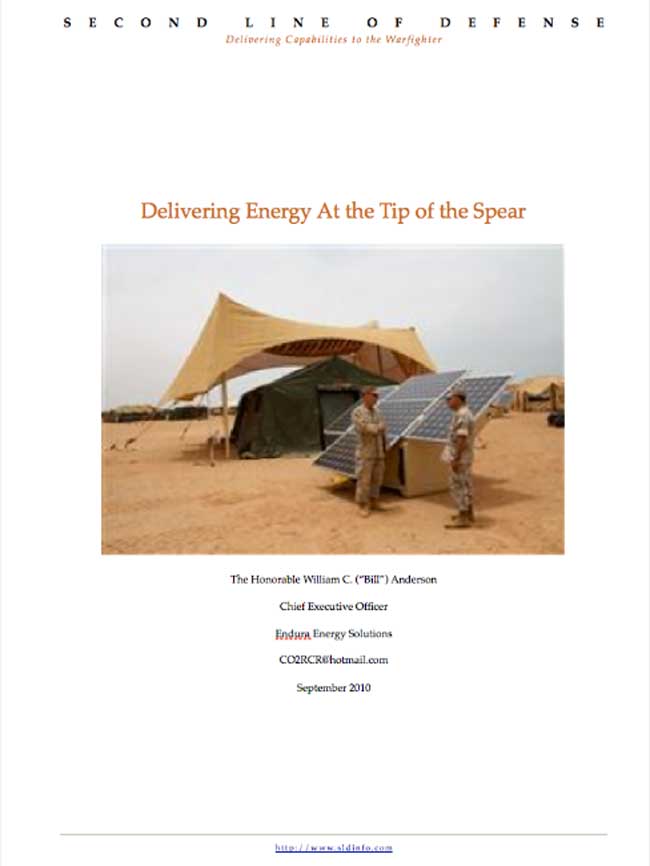Moving the Ball Forward: Shaping a Deployable Energy Policy bill
By Hon. Bill Anderson
The Honorable William C. (“Bill”) Anderson served as Assistant Secretary of the Air Force for Installations, Environment and Logistics and the Air Force Senior Energy Executive under President George W. Bush from 2005-2008. He currently serves as Chief Executive Officer of Endura Energy Solutions, a portfolio company of Pegasus Capital Advisors, L.P.. The author has business relationships with both ZeroBase and Hyperion Power Generation. He can be contacted at CO****@*****il.com.
This posting is the third of a three part posting of the Honorable Bill Anderson’s examination of how to deliver energy to the deployed warfighter. By enhancing the ability of the deployed force to self-sustain, a revolution in combat logistics can be generated. The complete article is published as a SLD special report in PDF format for downloading by readers.

10/17/2010 – What if we could incentivize the private sector to offer distributed alternative energy solutions that could provide energy and potable water at the point of use at forward operating bases and do it without large technology development earmarks…so, not spending an additional dime of taxpayer money? I believe that is exactly what can be done.
Remember the per kilowatt hour cost of energy delivered to the war fighter as we calculated it earlier? Tell any and all private sector vendors that they will be paid $2.00 for every kilowatt hour of electricity produced by alternative energy equipment the vendors would provide at FOBs, and just see how many “takers” would come forward.
Now, harsh environment testing would be required to make sure equipment could perform in the battle environment…and that testing could be done in the same accelerated fashion used to develop and deploy the MRAP…but these rough numbers illustrate a rather lucrative incentive…which should ratchet down as equipment costs come down and these new systems stabilize…to trigger development risk taking within the alternative energy technology development world. So, as General Powell recommends, it’s time to “go with your gut”.
On June 28, 2010, the Undersecretary of Defense for Acquisition, Technology and Logistics outlined a new initiative to reduce inefficiencies in procurement…calling on government contractors to do their part. What better time than in this era of ever-increasing demands and lower budget growth to allow true private sector market forces to identify, develop and offer commercial-ready portable distributed power generation options that are rugged enough to meet peculiar military needs.
This particular initiative could be an excellent target to test a new approach to identifying and deploying technologies that will certainly save lives…significantly reduce the environmental footprint of deployed forces…and might even improve the quality of life for our war fighters who will no longer be subjected to the noise and fumes of diesel power generating units…and, by the way, the heat signature of these generators which is a security risk in itself.
Certainly in the budget-constrained environment we face today, the DoD challenge to the private sector to assist in reducing waste and inefficiency in the system is a reasonable request. However, when a customer (in this case, the Federal government) demands a change in behavior from suppliers, the customer has an obligation to provide an environment that will support this change in behavior.
“Business as usual” on either side of the transaction will impede the desired change.
Furthermore, in the alternative energy space, the innovators are not likely going to be traditional military contractors. Those innovators will likely be private start-ups, NGOs and academic institutions. How do these organizations work their way into the status quo of military acquisition?
Or, maybe a better question might be, if the Pentagon is committed to (1) reducing waste and inefficiency, and (2) quickly finding real solutions to the dangerous and expensive practice of moving fuel and water to the battlefield by road, do we really want these new vendors falling into the acquisition status quo?
The “right” answer here is to facilitate testing and deployment of systems that are ready to go and that have private sector funding to move forward. That type of a market signal will drive innovation and risk taking, a real shake out/separation of good ideas from bad, and the elimination of waste commonly associated with the current military acquisition system.
Challenges Beyond the Military
Although this report has focused on particular military needs in harsh and remote locations, the performance characteristics of the units described above would logically meet requirements to address recovery efforts in natural disaster and homeland security scenarios. The disrupted supply chain, lack of energy feedstocks and limited access to fresh water faced after such catastrophic events beg for the functionality, portability and robust nature of the power units highlighted above.
In natural disaster/homeland security scenarios, speed of response is critical to the survival of those affected. If military organizations across the world utilized these transportable alternative energy units that did not require a feedstock supply chain in their combat operations, similar units would be maintained in reserve and at training bases across the globe. These reserve and training units could be quickly packed up, put on to a transport aircraft and delivered to the site of a disaster anywhere in the world within hours…providing much needed power and clean water…and certainly saving countless lives in the process.


